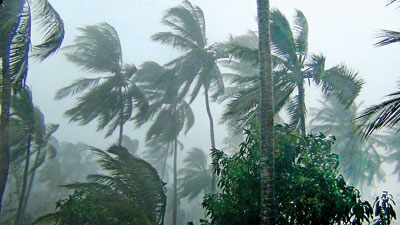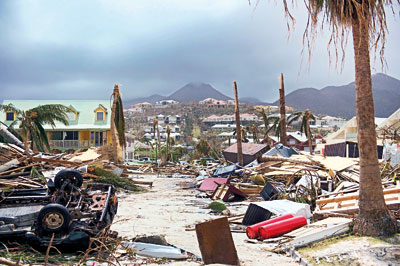Sunday Times 2
Cyclone season is close: Are we ready?
Cyclones are hazardous and have been responsible for considerable damage to property and life in the world and our country as well.

Sri Lanka in the claws of a cyclone (file pic)
Recent examples are Cyclone Harvey that caused havoc in Texas, USA last week and Irma that was to make a landfall in Florida, USA, yesterday after it devastated the Caribbeean islands in the days before. The severe cyclones that swept many parts of Sri Lanka in November 1978 and December 2000 are unforgettable examples on a local scale.
The tropical cyclone that developed in the Bay of Bengal in May, 2013 which was named ‘Mahasen’ also affected the weather over Sri Lanka resulting in a series of natural disasters such as flood, landslides, tornadoes and lightning. It also had very extreme weather characteristics that affected the lives of several fishermen who were engaging in fishing.
Cyclones that develop in tropical regions are called tropical cyclones. Terms such as hurricane, typhoon and Willy willy are also used by people in different parts of the world. Naming and numbering of cyclones over the globe has been in practice for more than four decades. This activity has been decided by the meteorological authorities on an important fundamental, mainly it is helpful in keeping records of cyclones that developed over all the oceans. Also numbering cyclones is based on their intensity estimated according to a number of parameters such as wind speed and pressure. In the Indian ocean, a cyclonic system is categorised as a cyclone when the wind speed around the centre exceeds 115 kilometres an hour.
For many reasons including man’s interference or contribution to change the natural environment into a somewhat unnatural environment, many natural phenomena like cyclones are now regarded as natural disasters. As the season with cyclones affecting Sri Lanka is ahead, it is worth discussing the natural disasters caused by cyclones.

A photo taken on September 7, 2017 shows damage in Orient Bay on the French Carribean island of Saint-Martin, after the passage of Hurricane Irma
An average cyclone is supposed to release an amount of energy which is equivalent to 200 times the worldwide electricity generating capacity — an incredible amount of energy. The total kinetic energy (including wind energy) generated has been estimated to be equivalent to about half the worldwide electricity generating capacity — also an amazing amount of energy. These figures may not be hundred percent accurate, but they can be quoted as approximate in the case of tropical cyclones (TC) in the Bay of Bengal. In comparison, a TC is supposed to be a heat engine that has the energy of more than 350 nuclear bombs.
Tropical cyclones form over all three oceans, Indian, Pacific and Atlantic every year, but the number may fluctuate seasonally or yearly. More than 50 TCs develop all over the tropical oceans in a year and five to six TCs develop in the Indian ocean, on average. A cyclone starts its life as a low-pressure area and intensifies into a depression and then into a cyclone if the required energy is available. Cyclone hazards are caused in a number of ways.
The paths of the cyclones also show peculiar characteristics. The cyclonic systems developing in the Northern Hemisphere move initially in a westerly to northwesterly direction, but while aging they tend to re-curve towards the northeast. For this reason, the cyclones that develop in the Bay of Bengal move towards us while intensification. Many parts of the Indian Ocean have a high probability of giving birth to the low-pressure areas but only those which develop in the Bay of Bengal considerably influence (directly or indirectly) weather over Sri Lanka.
The diameter of an intensified cyclone is in the order of 1,000 kilometres but the dimensions of the area affected by such a system may be very much wider than 1,000 km. Cloudy skies with fairly strong winds, gusty at times, and continuous rain or thundershowers are the normal weather conditions that prevail over many parts of the country when we are under the influence of a cyclone centered over, or in the vicinity of, Sri Lanka.
Coastal areas are affected by the surging storm, which are caused by the interaction of the winds associated with a cyclone and the surface water of the ocean. This interaction will increase the wave heights to values of about five to six metres and such waves cross the coast into the land. It is obvious that such waves will wash the property on the coastal regions away to the sea on their way back.
When a cyclone is close to the island, say about 500km from the eastern coast, it may show significant influence on weather parameters like wind and rain over the island and on waves over the adjoining sea area causing surges. In such situations, fishermen are warned to refrain from going out to sea. With the movement of such a system towards the island, the intensity of the hazardous effects will definitely increase and everyone under threat has to take all possible protection and precautions in order to reduce hazards.
The eastern parts of the island are the most vulnerable to cyclones that cross over or pass close to our island because the strongest surging winds and storms directly influence the eastern coastal areas. But depending on the intensity of a cyclone and its position, other coastal areas also may have effects of surging storms. Many low-lying areas are directly affected by strong winds, heavy rains and lightning and indirectly by floods. Those living in hilly areas have to face the hazards caused by small-scale or large-scale landslides and damage caused by huge uprooted trees which fall. Therefore, we should launch the precautionary steps to minimize the loss of life and damage to property well in time.
The frequency of cyclones developing in the Bay of Bengal is significant during October to December with a peak between November to December. This does not mean that cyclones definitely cross Sri Lanka in these months. The probability of the development of cyclonic systems in the Bay of Bengal is maximised during November to December. The path of such systems depends on a number of parameters and therefore the weather forecasters are not in a position to forecast the path well ahead until a system develops. But we have to realise that the weather in our country is affected significantly by cyclones developing in the Bay of Bengal whether they cross the island or not. The best example for this is the cyclone named Mahasen in May 2013 which did not move across Sri Lanka but caused significant disasters.
We are almost in the step of the cyclone season. It is our duty to take all precautionary measures that can be taken before such an event in order to minimise hazards.
(The writer is a visiting lecturer at the Post Graduate Institute of Science, University of Peradeniya and was a Director of Meteorology)

